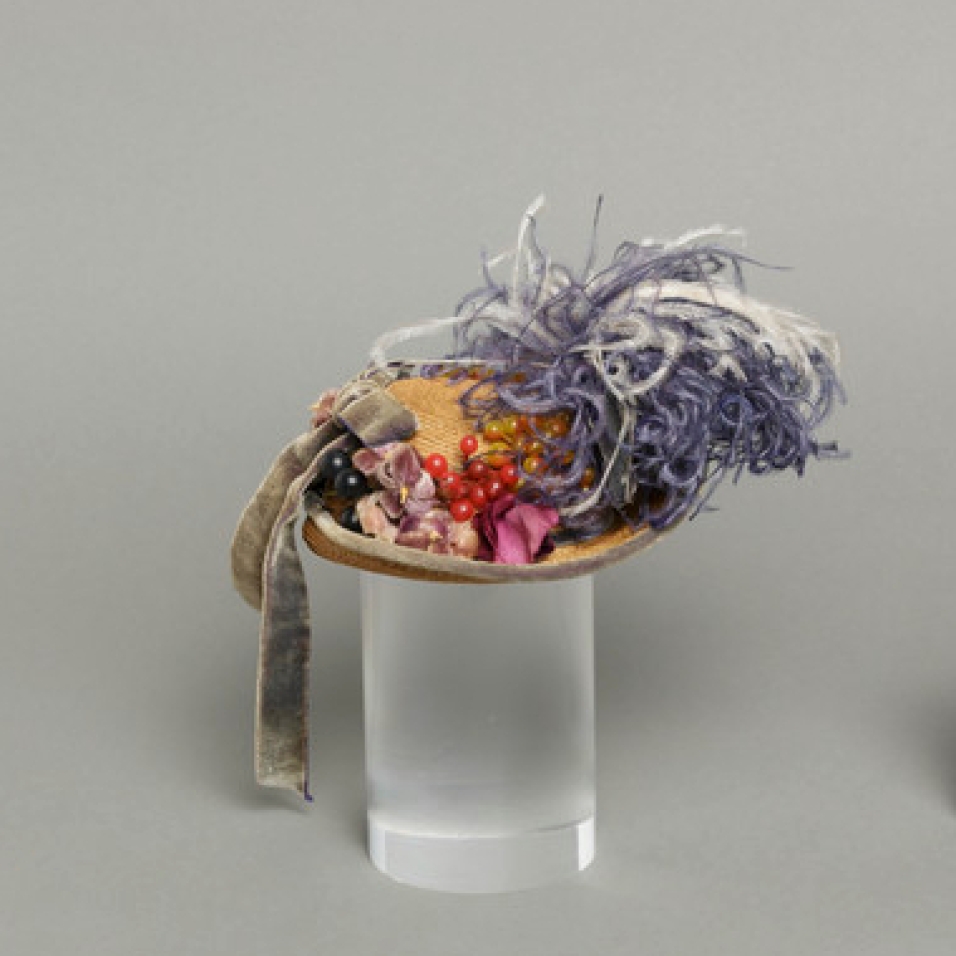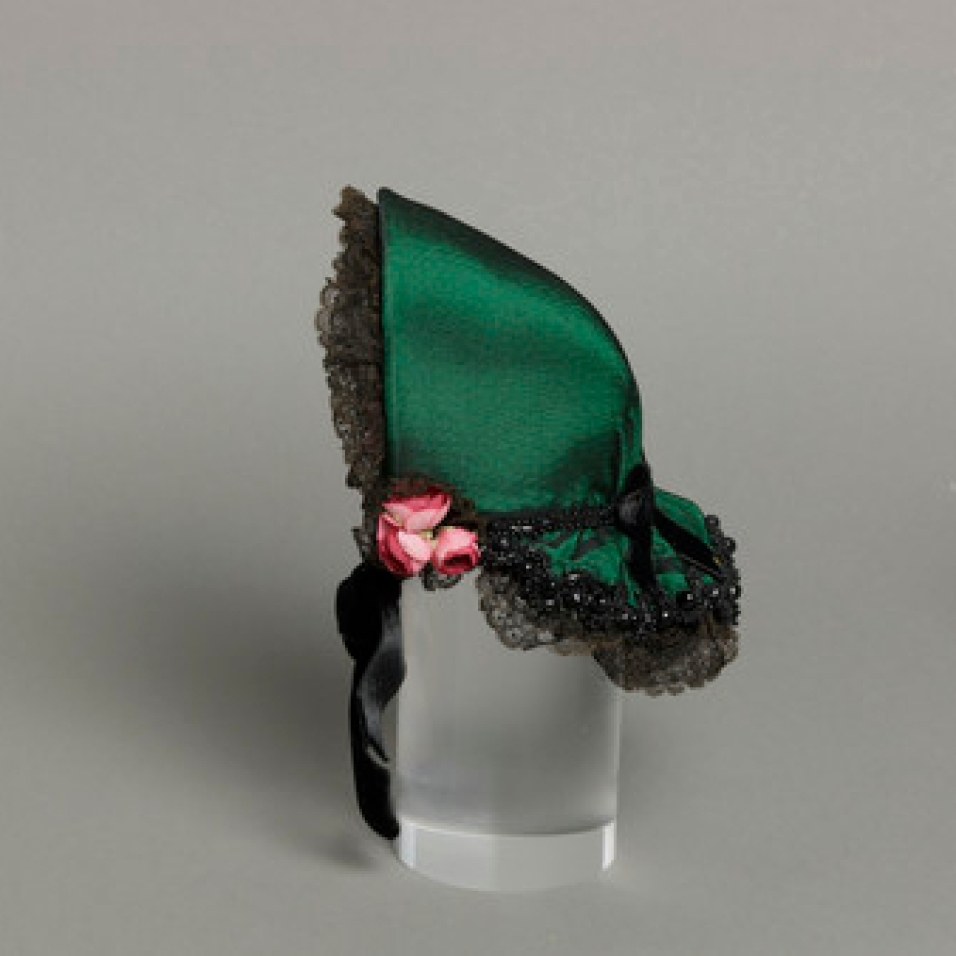Mildred Blount became the first African American member of the Motion Pictures Costumers Union. Her hats are in the collections of California African American Museum and Los Angeles County Museum of Art.
The goal is to create more period hats in miniature, which would serve as teaching aids, art, costume design and would also demonstrate the value of extended study in millinery.
– Mildred Blount, application for Rosenwald fellowship, 1943
Mildred Blount (1907-1974), milliner, is famously recognized for her costume work for major film studios, in particular, the iconic film Gone With the Wind (1939), although she was not credited for her work. She is also noted for an impressive list of famous clientele, including Marian Anderson, Joan Crawford, Marlene Dietrich, and Gloria Vanderbilt. Her talent took notice when she exhibited 87 miniature hats from the period 1680 to 1937, at the 1939 New York World’s Fair, which has defined the core of her legacy.
The photo images are part of 27 hat objects of Mildred Blount’s miniature period hat collection at Los Angeles County Museum of Art, circa 1939.

Mildred Blount’s legacy timeline:
- 1924 – Blount designed bridesmaids headwear for Madame C.J. Walker’s [the first Black woman millionaire who made her fortune in hair care products for Black women] granddaughter’s wedding.
- 1929 – Blount started employment at John-Frederics, Inc., one of New York City’s most fashionable establishments. They were surprised that a Negro would apply, so she asked them to give her a chance and they did.
- 1939 – Miniature hats and Gone With the Wind. Blount created 87 miniature period hats from the seventeenth to the nineteenth century and submitted them to the 1939 New York World’s Fair. They were on display the entire summer and because these period hats were unique and of the same period as Gone With the Wind, it caught the attention of Mrs. David Selznick, the wife of the producer of Gone With the Wind. Years later, an article on Blount in Ebony magazine, April 1946 recounted the following, “Her exhibit of hat miniatures at the N.Y. World’s Fair attracted the attention of Mrs. David Selznick, and ultimately landed John-Frederic the pot-of-gold assignment of the day – milliners to the tremendous cast of Gone With the Wind. Mildred did most of the work, although the credit line went to her employers.”
- 1941 – Blount created hats for the cast and actress Margaret Sullavan of the film Back Street (1941) as noted in Women of Rosenwald: Curating Social Justice Through the Arts (1928-1948), exhibit documents.
- 1942:
- Because of her talent and success with John-Frederics, Blount was promoted to senior hat designer and sent to Los Angeles to head up the salon in Beverly Hills. An article in The Afro-American, February 24, 1942 states her work on film and with the stars, “Just to show you how much her boss, John-Frederics, thinks of Miss Blount’s talent, he gave her the commission to do the hats for Gone With the Wind and Strawberry Blond. Now she manages his Hollywood shop and takes care of such customers as Joan Crawford and Katherine Dunham.”
- Blount’s hat on the cover of Ladies Home Journal magazine, August, 1942.
- She created the wedding veil for heiress, Gloria Vanderbilt.
- 1943 – The Afro-American, May 15, 1943, reported Blount was granted a Rosenwald [Julius Rosenwald was part owner, president, and chairman of board of directors of Sears, Roebuck, and Company] fellowship to make a collection of authentic miniature period hats. The article went on to say her most important work displayed at the New York World’s Fair is on permanent display at John-Frederics’ New York salon. In her application letter regarding the Rosenwald fellowship she clearly stated that she was not given credit for any of her work at John-Frederics, “I was never given any recognition for having done the work on them and the Good Housekeeping Magazine and the New York dailies as well as Look gave Mr. John credit for having made them himself.” She further expressed how this fellowship can advance the progress of other women, “my desire to do this work is first of all to acquaint all who see it with the hidden possibilities of women.”
- 1945 – Mildred Blount named “Outstanding Woman of 1944” by the Zeta Phi Beta Sorority, Los Angeles Tribune, February 19, 1945
- 1946 :
- Mid 1940’s Blount founded her own eponymous label in Los Angeles and had both private and celebrity clientele, while still doing work for the motion picture industry. She became known as the “milliner of the stars”.
- “Actresses think Blount hats bring love and good fortune,” as reported in The Afro-American, April 6, 1946 issue, referencing Ebony, April 1946 issue.
- 1948 – Blount designed hats for Judy Garland in the film, Easter Parade.
- 1954 – “Mildred Blount, the Los Angeles designer, will get screen credits in Columbia’s Joseph and His Brothers. She created the Egyptian headdress worn by the actors.” – Jet, September 30, 1954.
- 1955 – “Movie Costumers Union Admits Negro Hat Designer. In Hollywood, designer Mildred Blount was admitted to membership in the Motion Picture Costumers Union and became the first Negro to belong to the AFL affiliate. Membership in the MPCU permits Miss Blount, who designed hats for the “Ice Capades of 1956″, to work in motion picture studios.” – Jet, August 4, 1955.

“What’s New In Spring Hats”, by Mildred Blount, Ebony Magazine Cover, April 1946
Film fact:
Gone With the Wind film release, December 15, 1939. Hattie McDaniel won Best Supporting Actress for Gone With the Wind, becoming the first African American to win an Academy Award. The film has been criticized for its glorification of slavery, offering a white supremacist view of the past. Hattie McDaniel was racially segregated from her co-stars at the awards ceremony. She and her escort had to sit at a separate table at the back of the room.
Who Made the Hats for Scarlet O’Hara? Meet Mildred Blount is an example of a celebrated Black fashion maker’s untold story in A Study of Eight, a curated editorial project advancing the study of African Americans’ contribution to fashion history. Blount, although not credited for her work and overlooked for her contribution to American history, has been honored with her body of work in the collections of Los Angeles County Museum of Art and California African American Museum. At the height of her career, becoming the first African American member of the Motion Pictures Costumers Union, she finally received the recognition she deserved. Blount not only used her artistic talents for art, her miniature hat collection, costume design, as noted in the films in this story, and fashion, designing for her famous clientele; but used her talent to be an example of creative contributions from women. As she stated in her Rosenwald application letter, “my desire to do this work is first of all to acquaint all who see it with the hidden possibilities of women.”

Suggested additional study, sources, and documents:
- Women of Rosenwald: Curating Social Justice Through the Arts (1928-1948), Mildred Blount Biography.
- Women of Rosenwald: Curating Social Justice Through the Arts (1928-1948): Mildred Blount fellowship application and other documents.
- More on Mildred Blount and Gone With the Wind: documents of negotiations, contractual agreement, and list of hats made for Vivien Leigh’s character, Scarlett O’hara, between Selznick International Pictures [SIP] and John Frederics, Inc. – Ransom Center Magazine, Ransom Center Magazine is an online and print publication sharing stories and news about the Harry Ransom Center, Austin, Texas, its collections, and the creative community surrounding it.
- You Tube video documents media press on Mildred’s accomplishments.
- Background on The Afro-American newspaper, family-owned newspaper started in 1892, based in Baltimore, Maryland – pbs.org/blackpress/







